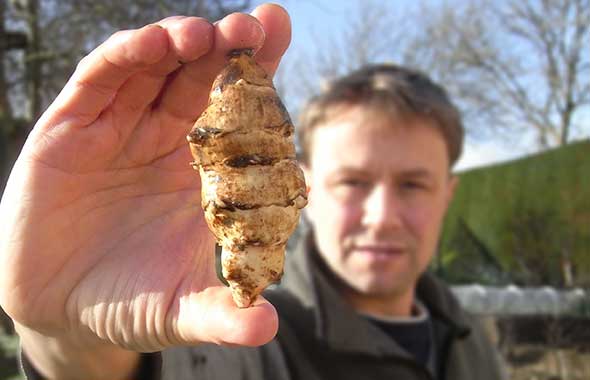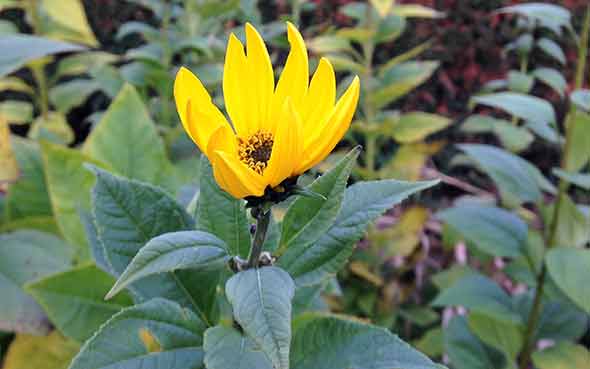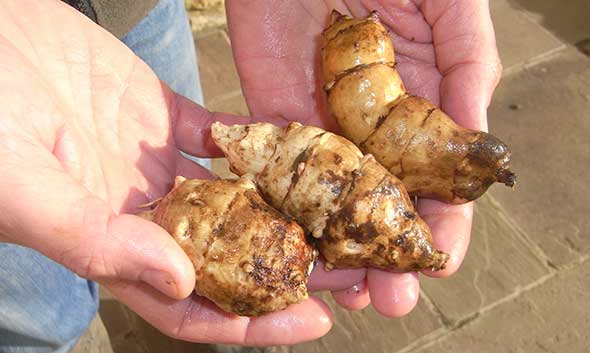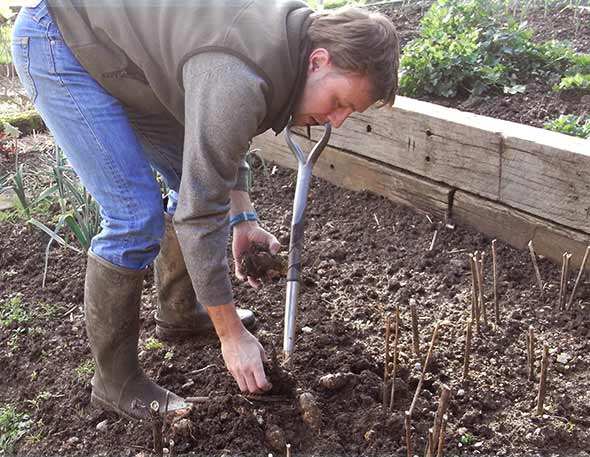Jerusalem artichokes (Helianthus tuberosus) or Sunchokes as they are sometimes called are one of those vegetables that are hard to find in the shops yet are very easy to grow in the vegetable garden. Planting just a handful of tubers will usually produce a bucket load of tubers when harvested so you don’t usually need to take up too much space when planting them.

Jerusalem artichokes are fairly common on allotments and as well as being a useful winter vegetable, are also very tall so during the summer months they can be a useful screen or windbreak. I have used them to hide an untidy water tank in a garden and to provide shade for chickens in the height of summer in my own garden. This height must be kept in mind when there are other vegetables growing nearby because they can grow nearly 9 feet tall, providing an area of shade behind them.
If they grow well, they will also flower. The flowers look like sunflowers but are much smaller; even so, the beauty of having flowers in the vegetable patch is a bonus and attracts many beneficial insects.

Jamie Oliver said Jerusalem artichokes “are sweet and almost garlicky and mushroomy and gorgeous” like a “rough and ready potato” in this receipe for Sautéed Jerusalem artichokes with garlic & bay leaves. With all the flavour of globe artichokes (only far easier to grow), they can be cooked in much the same way as potatoes can. We use them to make soups (the best ones we’ve found have curry powder in them) and we roast a few with potatoes for Sunday lunch but they can also be added to mashed potato to give it a different flavour or even cooked as chips.
Sow: November to March 6” deep, 12” apart in prepared trenches 3ft apart.
Harvest: November to March. Leave in the ground and dig as needed. Replant the smaller tubers for the next year.
Useful to Know: A useful windbreak and screen. Very easy to grow on almost any soil although a well prepared site with added organic matter will ensure they produce large tubers.
Potential Problems: Once planted, they can be difficult to get rid of because the smallest of tubers left in the ground will start to grow during the spring. If you want to clear the ground, it is best to dig over the ground lifting the tubers you find, then dig out any others that you’ve missed and start to grow during spring.
Rotation Class: Doesn’t require rotation – not susceptible to disease.

Jerusalem artichokes must be one of the easiest things you can grow in the vegetable garden, in fact I’m not sure I even need to provide information on how to grow Jerusalem artichokes because they seem to grow reasonably well wherever they are planted. Once established, they can be tricky to get rid of.
- Choose a suitable location, usually the back of your plot, since they will usually grow between 6 and 9ft tall.
- Plant between November and March.
- If you have a choice of tubers, choose those with the least knobbles. These are easier to peel so don’t encourage knobbles. See varieties below.
- To plant Jerusalem artichokes prepare a 2ft wide row, digging a spade’s depth.
- They will grow in almost any soil, although they will produce the largest tubers in soil that has had some well-rotted manure dug in to the soil 6-8 weeks before planting. Jerusalem artichokes prefer slightly acidic soil with an ideal pH of less than 6.5.
- Plant the tubers 6” deep and 12” apart. If one row isn’t enough (it usually is more than enough) then space rows 3ft apart. Keep them weed free.
- Provide support if they are in an exposed area by using a pair of posts at each end of the row. A wire can be run between the posts.
- Once the tops of the plants have died off (turned black) after the first frosts, cut the tops off. The tubers store best in the ground, especially if the tops are cut leaving about 12” of stem above ground. This also helps you to locate the tubers when digging them up.
- Dig as required through winter. See How to Store below.
Once Jerusalem artichokes are established, mulch them with well rotted animal manure annually. Dig up the largest tubers, leaving the smaller ones for the next year.
There are only a relatively small number of varieties of Jerusalem artichokes. The most common are relatively smooth which makes peeling less of a chore.
- Gerard – This is a French cultivar with white flesh and red skin that has been used in many restaurants. It has a smoky flavour that is considered to be the best by most chefs.
- Originals – As the name suggests, one of the oldest varieties. Originals are knobbly so make peeling more difficult.
- Stampede – High-yielding with white flesh and skin and good taste.
- Fuseau – Generally accepted to be the least knobbly variety of Jerusalem artichoke.
There are other varieties available in the U.S. such as Mammoth French White, Champion and Columbia which I haven’t seen in the U.K.
Jerusalem artichokes are best stored in the ground (assuming it is free draining, not water-logged) and dug up as required but will keep for up to a month in a cool dark place if you would like to dig a few at a time.

Jerusalem artichokes contain an indigestible starch called inulin. This means they are very low calorie and sometimes used in diets. They are also a pre-biotic (which helps to feed good bacteria in your gut) although there is one down side to eating them fresh: inulin causes flatulence and this is how Jerusalem artichokes have picked up the name of ‘fartichokes’ in some allotment sheds!
Inulin starch changes to other starches similar to those found in potatoes during storage, so they lose their low calorie benefits but if you find the wind aspect off-putting then you may find storing them in a cool dark place for a couple of weeks before use will help.
